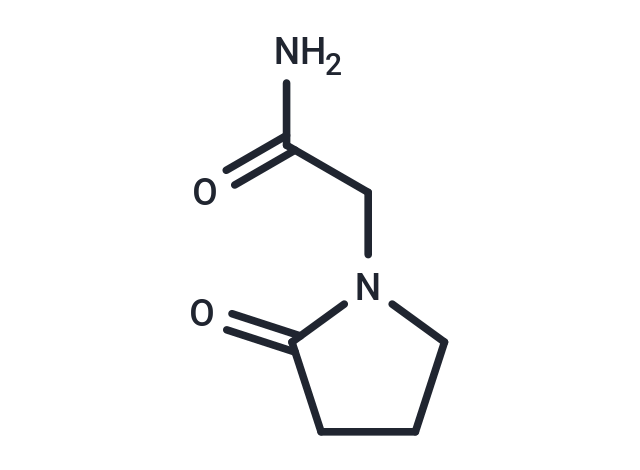Shopping Cart
Remove All Your shopping cart is currently empty
Your shopping cart is currently empty
Piracetam (UCB-6215), a cyclic derivative of the neurotransmitter gamma-aminobutyric acid (GABA), is used in therapy of the extensive cognitive disorders.

| Pack Size | Price | USA Warehouse | Global Warehouse | Quantity |
|---|---|---|---|---|
| 1 g | $30 | In Stock | In Stock | |
| 1 mL x 10 mM (in DMSO) | $50 | In Stock | In Stock |
| Description | Piracetam (UCB-6215), a cyclic derivative of the neurotransmitter gamma-aminobutyric acid (GABA), is used in therapy of the extensive cognitive disorders. |
| In vitro | Excluding the cerebellum, Piracetam enhances active avoidance learning in aged rats and increases membrane fluidity across all brain regions. A daily dose of 300 mg/kg Piracetam significantly boosts membrane fluidity in certain cerebral areas of aged rats without noticeable effects on juvenile rats. Six weeks of daily administration of 300 mg/kg Piracetam elevates NMDA receptor density in the hippocampus, as well as the density of muscarinic cholinergic receptors in the frontal cortex and striatum, with a slight increase also observed in the hippocampal region. Oral administration of 500 mg/kg Piracetam for 14 consecutive days increases NMDA receptor density by approximately 20% in aged mice and restores the normal affinity of L-glutamate for NMDA receptors. Compared to control and alcohol-fed rats, those treated with Piracetam show a 20% increase in synaptic numbers, suggesting a mechanism of synaptic reorganization at the level of mossy fiber synapses. |
| In vivo | Piracetam, when pre-incubated with lipopolysaccharides (at Piracetam to peptide ratios ranging from 9.6 to 960), can dose-dependently inhibit the peptide-induced release of calcein completely. It has been observed through the reduced anisotropy of the membrane-bound fluorescent probe 1,6-diphenyl-1,3,5-hexatriene (DPH) that Piracetam (< 1.0 mM) can enhance the membrane fluidity of brain cells in aged rats, mice, and humans. Piracetam significantly reduces the fusion and destabilizing effects of Abeta 29-42 in a concentration-dependent manner. Pre-incubating Piracetam with the peptide at a 960 ratio, 20 minutes before introducing Abeta 29-42, fully protected both types of fluorescent probes. |
| Synonyms | UCB-6215 |
| Molecular Weight | 142.16 |
| Formula | C6H10N2O2 |
| Cas No. | 7491-74-9 |
| Smiles | NC(=O)CN1CCCC1=O |
| Relative Density. | 1.2298 g/cm3 (Estimated) |
| Storage | Powder: -20°C for 3 years | In solvent: -80°C for 1 year | Shipping with blue ice/Shipping at ambient temperature. | |||||||||||||||||||||||||||||||||||
| Solubility Information | DMSO: 50 mg/mL (351.72 mM), Sonication is recommended. H2O: 351.72 mM, Sonication is recommended. | |||||||||||||||||||||||||||||||||||
| In Vivo Formulation | 10% DMSO+40% PEG300+5% Tween 80+45% Saline: 2 mg/mL (14.07 mM), Sonication is recommended. Please add the solvents sequentially, clarifying the solution as much as possible before adding the next one. Dissolve by heating and/or sonication if necessary. Working solution is recommended to be prepared and used immediately. The formulation provided above is for reference purposes only. In vivo formulations may vary and should be modified based on specific experimental conditions. | |||||||||||||||||||||||||||||||||||
Solution Preparation Table | ||||||||||||||||||||||||||||||||||||
DMSO/H2O
| ||||||||||||||||||||||||||||||||||||
| Size | Quantity | Unit Price | Amount | Operation |
|---|

Copyright © 2015-2025 TargetMol Chemicals Inc. All Rights Reserved.